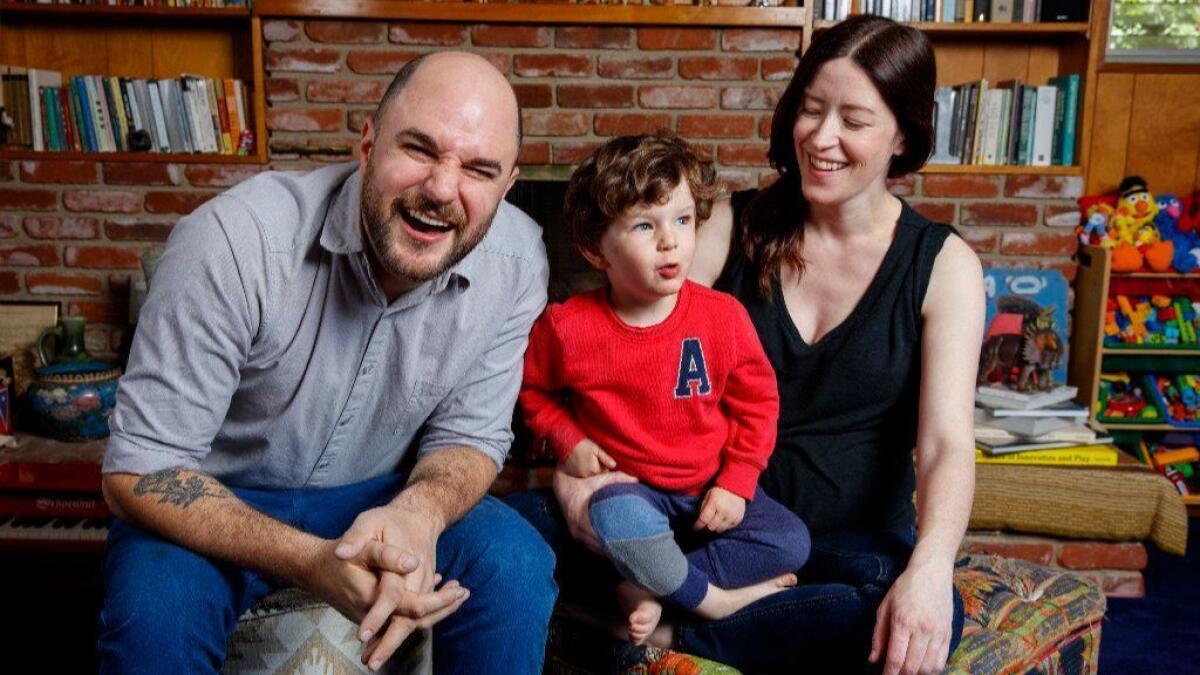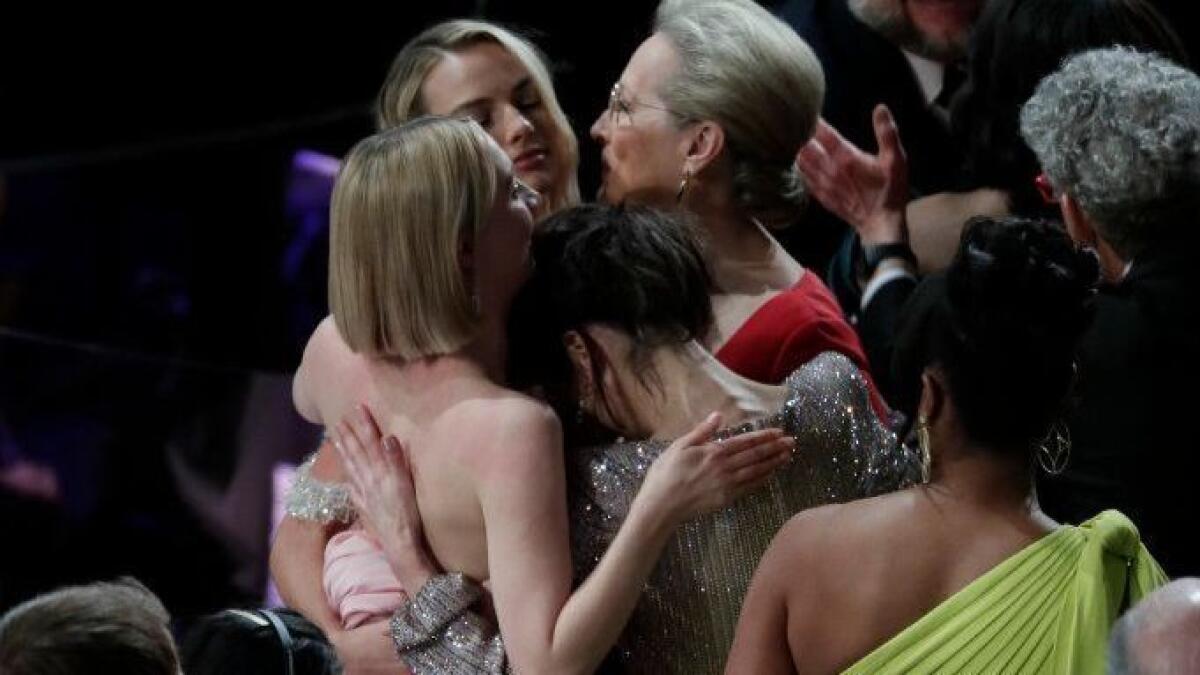‘Fast Color’ turns the superhero genre upside down, with a woman of color — and a mother — in the lead
- Share via
In the post-“Black Panther” era of inclusion and representation for all, the superhero we need and deserve is a woman.
Her name is Ruth, and in filmmaker Julia Hart’s “Fast Color,” she traverses a dreary pre-apocalyptic American landscape, running from the uncharted magnitude of her unique gifts and from the powers-that-be who seek to stifle them.
She is a mother. She is a daughter. She is a woman of color. And in Hart’s vision of female power, world-premiering Saturday at the South by Southwest Film Festival, she is the future.
“‘Fast Color’ came out of this idea of moms as superheroes,” explained Hart, on a sunny Los Angeles afternoon ahead of her SXSW premiere. “I’d never seen a mom who was literally a superhero in a movie before.”
Gugu Mbatha-Raw stars opposite Lorraine Toussaint, Christopher Denham, David Strathairn and Saniyya Sidney, breathing quiet emotional life into the broken Ruth, who finds herself pulled toward home as the drought-ridden world around her slowly dies.
Like Hart’s 2016 directorial debut “Miss Stevens,” an indie charmer inspired by her tenure as a young high school teacher, the roots of “Fast Color” grew from personal experience — and a frustration with the ways the same characters and stories kept being told within the superhero genre.
“Male superheroes are by and large, prior to movies like ‘Black Panther,’ about white men destroying things in order to save them — which is so… men, to do it that way,” smiled Hart, who co-wrote the multi-generational tale with her husband, Oscar-nominated “La La Land” producer Jordan Horowitz.
Instead of wielding innately destructive powers, Ruth’s gifts — manifested in stunning bursts of mesmerizing visuals in the purposefully ordinary world of “Fast Color” — are forceful and yet uniquely feminine in nature.
“What would the female power be? It would be creation,” explained Hart, who directed “Fast Color” over a 28-day shoot in New Mexico, capturing the state’s stunning magic hour vistas with cinematographer Michael Fimognari. “So what could a superpower be that could lead to creating something, instead of destroying something in order to save it?”
Hart, 35, and Horowitz, 37, collaborated previously as co-writers on “Miss Stevens,” which he also produced — and on Arthur, their three-year-old son, who gambols across the cobalt blue carpet of their Westside home helpfully assisting mom and dad as they have portraits taken ahead of their trip to SXSW.
Their second child is on the way, due to arrive later this year before Hart directs her third film, an adaptation of the young adult novel “Stargirl,” for Disney’s new streaming service.
As Hart discusses “Fast Color” and her own fast-moving career, her hands caress her belly and the subject of motherhood often comes up as a source of power and inspiration.
“I didn’t decide to even be a director until I became a mom,” said Hart, who was working as a high school teacher when she wrote her first screenplay, the female-driven Civil War thriller “The Keeping Room.” Her script landed on the Black List and landed her an agent, and was turned into a film starring Brit Marling. Watching it get made after becoming pregnant with her first child, Hart realized she wanted to direct.
“I always thought I would be a writer, but in spite of feeling like I was a confident, strong feminist, I was afraid to take that leap until I took that leap into writing,” she explained. “I don’t quite know what the connection is, but becoming a mom was the most powerful I’d ever felt — so I felt empowered to take on the role of director.”
“I thought, ‘I have the power in me to bring my stories to fruition – I don’t need someone else to do it for me.’
Hart and Horowitz, both theater-loving New Yorkers, first met in their early 20s through mutual friends. Love came first, then a move to Los Angeles, and eventually, their entwined careers in show business.
“We fell in love the night we met,” smiled Hart.
Horowitz grinned, glancing at her. “That’s not to say it’s always been –“
“Easy!” she added, finishing his sentence. “I remember in your little apartment on the Lower East Side, on your crappy TV, watching ‘Alice Doesn’t Live Here Anymore’ and ‘Wild at Heart.’”
“We watched ‘Stroszek’ on that TV!” he nodded.
“We definitely started then what is now our life together, making movies and watching movies and having children.”
After making “The Keeping Room” and “Miss Stevens” together, the couple were writing “Fast Color” for Hart to direct when they caught Gina Prince-Bythewood’s “Beyond the Lights” — and were blown away by Mbatha-Raw’s breakout starring turn. The British actress immediately became their first choice to star as Ruth.
“We watched it and were like, ‘Holy… who is that?’ That performance going unrecognized is a travesty,” said Hart. “Gina Prince-Bythewood is such an extraordinary filmmaker, and Gugu’s performance… I have goosebumps just thinking about it. Who Gugu is as a person is so separate from who she is onscreen. She’s such a chameleon.”
You don’t have to sit down and conceive of a story about race specifically ... you just have to have an imagination in your casting.
— “Fast Color” writer-director Julia Hart
Mbatha-Raw read the script and found herself drawn to Ruth’s “woman on the run” journey. “As I got deeper into the story, I realized that she was on the run from herself, and that’s when it really got interesting for me,” she said via email.
“I found it refreshing that unlike other superhero worlds we’re used to seeing, this landscape felt very grounded — there were no capes or spandex... it is about the power that we all have as women inside of ourselves, if we only have the courage to release our own fear and embrace it.”
She signed on to star for Hart, and suddenly “Fast Color” took on greater layers as Ruth — who was not written to a specific ethnicity — became multiracial in the casting. Toussaint (“Orange Is the New Black”) came onboard to play her mother Bo, and Sidney (“Fences”), who was 10 years old at the time of filming, was cast as her daughter, Lila.
“In casting Gugu, what started out as a movie about female empowerment became about the empowerment of women of color,” said Hart. While her ethnicity is ingrained in the story, it is not the story, making “Fast Color” — like Disney’s “A Wrinkle in Time,” which also features Mbatha-Raw — an example of the kind of normalized, effortless representation Hollywood can move toward.
“Representation matters, and in order to be a part of that movement and making sure that there aren’t just stories about white men and white women, you don’t have to sit down and conceive of a story about race specifically,” said Hart.
“You just have to have an imagination in your casting. Because it was, ‘Oh my god, this is the most talented actress of her generation and she would be so amazing in this part’ — and the world expanded from there.”
At a time of high awareness in the entertainment industry around inclusion and representation, both Hart and Horowitz are supporters of the Time’s Up movement and have used their platforms, particularly on social media, to be advocates for elevating underrepresented voices. That imperative extends to their creative work too, says Hart.
“We want to be a part of telling more stories and making sure that every little girl and every little boy gets to walk into a movie theater and gets to see themselves and has a story about themselves,” she said. “‘Fast Color’ became this thing that was bigger than us, and bigger than the movie. I feel so lucky that I get to be a part of telling more representative stories, because I think it’s the future.”

They are among a generation of emerging artists who are making Hollywood feel increasingly communal, not competitive. No one was more proud than Hart when, at the 89th Academy Awards, Horowitz became an Oscars hero when he stepped up to the microphone in front of millions to tell the “Moonlight” crew they had actually won best picture, not his own “La La Land,” as originally announced.
“It was crazy!” said Horowitz, who suddenly found himself in the spotlight. “We went to make ‘Fast Color’ two days after the Oscars last year… it was nice to get away.”
This year’s Academy Awards were a much more relaxed affair for Hart and Horowitz, who had a lot of friends to cheer for, including “Call Me By Your Name” nominee Timothée Chalamet, who starred in “Miss Stevens.”
“Sitting at the Oscars Sunday night and hearing his name called and his little face up on that big screen — it was so wild,” said Hart. “And Mahershala and Greta and Timothée and Kumail and Emily,” added Horowitz.
Hart reflected on a year of personal and professional milestones paralleling bigger changes she sees happening in the industry.
“I don’t want to use the word ‘great,’ because a lot of it has been about pain,” she observed. “But it’s been a revolutionary year, both in terms of what’s happening in terms of #MeToo and Time’s Up, and the type of work that is coming out of that. Movies like ‘Wonder Woman,’ ‘Black Panther,’ ‘The Big Sick,’ ‘Get Out’” –
Horowitz: “And ‘Moonlight’ winning last year…”
Hart nodded in agreement. “All of this really good stuff is coming out of all of this really bad stuff.”

One 2018 Oscars moment in particular reminded Hart of the kind of unifying power she hopes to convey onscreen and see build in the world around her.
“After Frances McDormand gave her amazing speech and left the stage, all of the other best actress nominees got up and hugged in the middle of the auditorium,” she said. “It was this incredible moment, and I thought, ‘Only women would do that.’”
Hart is conscious of the fact that in seeing her make movies, others may also be inspired to follow suit.
“There’s your art, and you make your art for art’s sake,” she said. “But there’s also an awareness that I can point to in the work I’m doing and the kind of person I am, in order to hopefully get little girls excited about the fact that you can be a woman and tell your own story. You can be a mom and tell your own story.”
Taking “Fast Color” to SXSW in the wake of “Wonder Woman” and “Black Panther” adds Hart’s unique vision to a genre that is widening in scope. And while Hart’s film was made outside of the studio system and is seeking distribution, box office receipts are proving that audiences want to see new perspectives in their superhero movies.
“At the end of the day, we’re artists. What can we do?” Hart reflected on the idea of sending “Fast Color” into the world to find an audience. “I feel like the world is finally waking up to the fact that the stories that we tell in this business actually affect the world. It affects how children see themselves, it affects how children feel about themselves, and what they feel inspired and empowered to go out and do.
“And if kids are not seeing themselves in the movie theaters that they go to, then there is a limit to what they think they’re capable of. It changes the world. We can do that with our art as best as we can. You hope people get to see it.”
More to Read
Only good movies
Get the Indie Focus newsletter, Mark Olsen's weekly guide to the world of cinema.
You may occasionally receive promotional content from the Los Angeles Times.











